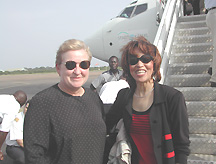
| T H E N I H C A T A L Y S T | M A Y – J U N E 2002 |
|
|
|
Journey to Africa with the HHS SecretaryPREPARED TO MAKE A DIFFERENCE |
text
by Yvonne Maddox photos
by Corina Gardner |
 |
|
Yvonne
Maddox (right), met by U.S. ambassador to Ghana Nancy Powell upon arrival
at Kotoka International Airport, Accra
|
As I climbed the steep steps of the KC 135 military aircraft—a refueling plane—I knew that my trip to sub-Saharan Africa would be the experience of a lifetime. The mission for our 27-person delegation was "to develop an understanding of the countries’ health care delivery systems and to see how the United States might . . . partner with colleagues in Africa." Our six-day itinerary would take us to Mozambique, South Africa, Botswana, and Côte d’Ivoire.
The mission was headed by DHHS Secretary Tommy Thompson; the troops were leaders from NIH, CDC, FDA, HRSA, Congress, the White House, the National Security Council, the Department of State, USAID, private nongovernmental organizations, academia, and the pharmaceutical industry. As we left from Andrews Air Force Base Easter evening, March 31, Thompson advised us that our job was "to look and see, listen and hear, and return to this place prepared to make a difference." En route to Mozambique, NIAID Director Tony Fauci briefed us on scientific and biomedical issues facing Mozambique and other African nations.
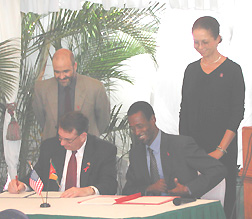 |
|
Tommy
Thompson (seated, left) and Mozambique Minister of Health Francisco Songane
sign a Memorandum of Understanding, as (left) Dr. Alfredo Vergara, epidemiologist
for the Mozambique Unit of the DHHS Global AIDS Program, and U.S. ambassador
to Mozambique Sharon Wilkinson look on
|
Maputo, Mozambique
Despite the bleak economic picture (see "Out of NIH") and devastating floods in the past year, Mozambique draws strength from new leadership and continuing health projects with the United States and others.
HHS is currently working with the Ministry of Health to enhance HIV surveillance, prevention, and treatment in partnership with the National AIDS Council and nongovernmental organizations. HHS has also helped Mozambique prepare a proposal to the Global Fund, which could provide significant support.
A key part of our visit was making a commitment for future collaborations. Secretary Thompson and Mozambique’s minister of health, Francisco Songane, signed a Memorandum of Understanding outlining HHS and USAID cooperation with Mozambique’s Ministry of Health in an integrated and comprehensive approach to the AIDS pandemic.
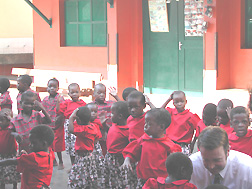 |
|
Children
at the Sisters of Charity orphanage in Mozambique; (foreground) Scott
Evertz, director of the White House Office of National AIDS Policy
|
A highlight of the Maputo visit was a tour of the Primeiro de Maio Health Center, where Thompson saw an HHS-supported initiative, to be launched this summer, to integrate networks of care for people with AIDS. Visits to the Sisters of Charity Orphanage and cholera tents at Mavalane Hospital made an indelible impression on all of us.
Pretoria, South Africa
An hour by jet from Maputo found us at our next stop—Waterkloof military base, South Africa. The health needs of the country are staggering, as every day brings 1,800 new HIV cases. The AIDS death rate is projected to double in the next five years. Thompson had requested a formal meeting with the health minister, Dr. Manto Tshabalala-Msimang, to discuss health-sector cooperation and priorities. One of the Health Ministry’s most urgent requests was for help in establishing medical infrastructure, including Global Fund money for HIV/AIDS. We had fruitful discussions on the long-term effects of nevirapine and other AIDS therapies in this country with limited resources.
HHS’ research at several South African field sites on prevention of mother-to-child transmission of HIV has strong support, but Tshabalala-Msimang wanted to discuss other health concerns—food safety, TB and other infectious diseases, teen pregnancy, nutrition, and biotechnology. She promised to visit NIH in the upcoming months to pursue these issues.
A one-hour bus trip through the hills of South Africa took us to the St. Francis Care Center, a hospice and nursery for AIDS orphans in Boksburg. We gave hugs, smiles, and encouragement to the children and their caretakers, but what was most needed were drugs that could improve and prolong lives. Our aid to South Africa must focus on this.
The Ford Corporation of South Africa provided a bright spot. Their assembly plant in Mamalodi has a workplace program for HIV prevention, education, and HIV/AIDS care for workers, their families, and the community. CDC now has cooperative agreements with the American Center for International Labor Solidarity (ACILS) to help South African trade unions establish similar programs. Thompson signed a new agreement with ACILS, continuing DHHS support.
The next day we viewed how the South African military is coping with HIV/AIDS in its "Masibambisane ‘Beyond Awareness’ Program." To determine the effect of HIV and to combat the spread of AIDS in the military, the South African National Defense Forces teamed up with the U.S. Department of Defense to support an educational campaign. If successful, this pilot program may be extended to other countries with U.S. military connections.
 |
|
Youth
dancers of Gabarone performing at a groundbreaking ceremony for a new
Tebelopele Voluntary Testing and Counseling site
|
Gabarone, Botswana
Travel to Gabarone was a return trip for me. A little over a year ago, I opened an NICHD conference there on treatment of women and children with AIDS. That conference, like the current visit, highlighted the progress Botswana has made in combating HIV/AIDS. The president of Botswana, Festus Mogae, calls AIDS the "challenge of the millennium."
Indeed, Botswana now ranks as one of the four countries hardest hit by the AIDS pandemic. According to the latest UNAIDS report, AIDS will account for a fourfold increase in the death rate in this country by 2005. There is a bright side, however, in that the new minister of health, Joy Phumaphi, has made a commitment to drug therapy for AIDS and to adopting the global standard for TB control. These are major steps in a country that still relies heavily on traditional healing. Phumaphi took the extraordinary step of publicly taking a HIV test two years ago and is a strong voice for Mogae’s anti-AIDS campaign.
The delegation was greeted and guided throughout the Botswana leg of our trip by Phumaphi and U.S. Ambassador John Lange. We began with a luncheon to celebrate public-private partnerships with U.S. institutions that are helping Botswana fight HIV/AIDS and TB. This included researchers and staff from the NIH-Harvard-Botswana Partnership for HIV research and education, the HHS BOTUSA (Botswana/USA) Project, Bristol-Myers Squibb, and the Gates/Merck Initiative.
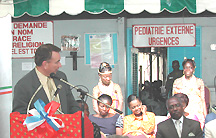 |
|
Tommy
Thompson at the ribbon-cutting ceremony at Port Bouet General Hospital,
Abidjan; seated at right is Minister of Health Abouo N’Dory Raymond
|
We then got a closer look at the BOTUSA Project—a collaborative effort with the CDC that started in 1995 as an innovative AIDS project for "Prevention of Mother-to-Child-Transmission" (PMTCT). The project provides more than 200 cross-country traveling antenatal counseling and educational clinics. It also offers HIV outreach activities for youth, such as radio drama, theater, and music. Key to the BOTUSA Project are the Tebelopele ("make a new start today") Centers. These free, voluntary counseling and testing centers operate under the premise that the gateway to HIV prevention and care is knowing one’s HIV status. Thompson, Phumaphi, and Lange pitched the first spades of earth in a groundbreaking ceremony at the site of a new Tebelopele center, where we were entertained by local youth in their dance of the spirit.
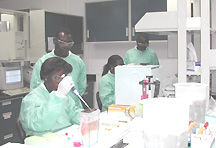 |
|
HHS-supported
virology lab at Port Bouet, Abidjan
|
Abidjan, Côte d’Ivoire
A four-hour flight put us in the country once called the Ivory Coast. The HIV/AIDS pandemic is ravaging this country, and the number of children who have been orphaned is horrific. Malaria and TB are serioushealth problems as well. U.S. Ambassador Arlene Render met us for what would be a whirlwind eight-hour visit.
At Port Bouet General Hospital, we had the opportunity to interact with HIV-positive clients who had come for group counseling, which appears to save money, build acceptance, and reduce the stigma of AIDS. Secretary Thompson unveiled a plaque commemorating the donation of a group counseling room on behalf of the American people. He also officially launched the DHHS Global AIDS Program’s PMTCT activities in that country.
Dating to 1988, one of the longest-running HHS projects in Africa is the Project Retro-CI, a HIV/AIDS epidemiological and laboratory research project in Abidjan. Partners in the collaboration are the CDC, the Côte d’Ivoire Ministry of Public Health, and the Institute of Tropical Medicine, Antwerp, Belgium. In 2000, HHS added primary prevention, surveillance, and treatment components. Our delegation toured the virology and clinical labs, which are focusing on vaccine research, antiretroviral treatment, and HIV diagnostics.
The Last Leg and the Next Steps
From Abidjan, we headed back to Germany and the military plane that would get us back home slightly before noon, Saturday, April 6. Secretary Thompson will soon be meeting again with the delegation to determine our next steps.
I learned a lot from this trip across sub-Saharan Africa—not only that these four countries have quite different cultures, beliefs, and public health needs but also that their peoples share both the pain and the courage that are the concomitants of poverty and pandemic.
I saw the scourges of
AIDS and other infections—and the courage of young volunteers in the AIDS
counseling and testing centers as they told us about their strategies for counseling
the partners of HIV-positive people. I will not forget the orphaned toddlers
who danced with us or the wailing patients in the cholera tents or the strong
voices of African leaders who believe their countries will survive. And I believe
that my country will help to make that so. ![]()
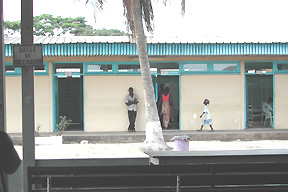 |
|
Outside
the vaccination clinic at Port Bouet Hospital
|
|
The countries visited by the DHHS delegation and NIH’s current activities there are listed below. Mozambique: Area: 300,000 sq. mi. Population: 19 million Infant mortality: 139/1,000 live births Life expectancy: 36 years Notes: 70 percent of the population is below the poverty line; average per capita income is $230 per year. NIH grants: Three extramural awards as components of domestic awards, $107,000 total (FIC, NIGMS)
South Africa: Area: 475,000 sq. mi. Population: 44 million Infant mortality: 60/1,000 live births Life expectancy: 48 years Notes: 4 million South Africans are now infected with HIV–the largest number of any country in the world. NIH grants: Bilateral agreements on Science and Technology and public health, including HIV/AIDS; six extramural research grants; 25 awards as components of domestic awards; 5 visiting scholars; 3 international research fellowships; $10,089,000 total (NCI, NHLBI, NIAAA, NICHD, NIAAA, NIDA, NIDCR, NIGMS, NIMH, NINDS, NIAID, FIC)
Botswana: Area: 225,000 sq. mi. Population: 1.5 million Infant mortality: 63 deaths/1,000 live births Life expectancy: 37 years Notes: 36 percent of adults are HIV positive; approximately one baby in Botswana is infected with HIV every hour. NIH grants: Nine extramural awards as components of domestic awards or Extramural Training Grants; $2.3 million total (NIAID, NIMH, NICHD, FIC)
Côte D’Ivoire: Area: 125,000 sq. mi. Population: 17 million Infant mortality: 94 deaths/1,000 live births Life expectancy: 45 years Notes: 48 percent literacy rate. NIH grants: Two extramural awards, $341, 707 total (FIC, NICHD) |